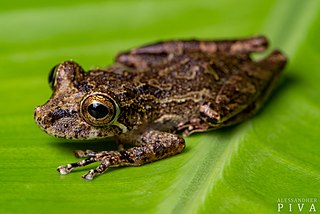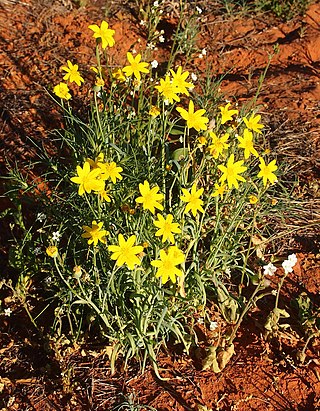
Heritiera littoralis, commonly known as the looking-glass mangrove or tulip mangrove, is a mangrove tree in the family Malvaceae native to coastal areas of eastern Africa, Asia, Melanesia and northern Australia. The common name refers to the silvery appearance of the underside of the leaves, resembling a mirror to some degree. The strong timber has uses in marine applications and elsewhere.

Centaurea gymnocarpa, also known as fiordaliso di Capraia (Italian) is a species of flowering plant in the family Asteraceae. It is a rare species endemic to Italy found only on Capraia, a small island located in the Tuscan Archipelago, with the species being distributed across 8 subpopulations on the island's surface. Its natural habitats are Mediterranean-type shrubby vegetation and rocky areas, colonizing in the cracks and fissures of cliffs.

Leucheria suaveolens, the vanilla daisy, is a species of flowering plant in the family Asteraceae. It is endemic to Falkland Islands. Its natural habitats are temperate shrubland, rocky areas, and rocky shores. It is threatened by habitat loss.

Senecio gallicus, an annual plant of the genus Senecio and family Asteraceae, is a species that colonizes isolated habitats with difficult environmental conditions. It is widespread across southern France and the Iberian Peninsula in deserts and xeric shrublands, on steppes and salty dry coastal plains. S. gallicus is playing a predominant role in shaping patterns of genetic structure by presenting models of historical associations among population rather than patterns of ongoing gene flow.

Senecio iscoensis or Aetheolaena senecioides is a flowering plant in the aster family. It is found only in subtropical and tropical dry shrubland in Ecuador. It is threatened by habitat loss.
Senecio lamarckianus, the bois de chèvre, is a species of flowering plant in the aster family and a member of the genus Senecio. It is endemic to the island of Mauritius and is threatened by habitat loss.
Senecio vaginatus, the smooth ragwort, is a species of flowering plant in the aster family. It is endemic to the Falkland Islands. Its natural habitats are temperate shrubland, rocky shores and other rocky areas. It is threatened by habitat loss.
Lomanthus fosbergii, synonym Talamancalia fosbergii, is a species of flowering plant in the family Asteraceae endemic to Ecuador. Its natural habitat is subtropical or tropical moist montane forests. It is threatened by habitat loss. It was first described by José Cuatrecasas in 1953 as Senecio fosbergii. The genus Lomanthus is placed in the tribe Senecioneae.
Hyloxalus littoralis is a species of frog in the family Dendrobatidae. It is endemic to Peru where it is known from Lima, Huánuco, and Ancash Regions. Population near Lima was an introduction one and may now be extinct. It natural altitudinal range is 665–2,180 m (2,182–7,152 ft) asl.

Ololygon littoralis is a species of frog in the family Hylidae. It is endemic to Brazil. Its natural habitats are subtropical or tropical moist lowland forests and intermittent freshwater marshes. It is threatened by habitat loss.

The drab water tyrant is a species of bird in the family Tyrannidae, the tyrant flycatchers, and is the only species in the monotypic genus Ochthornis. It is found in Bolivia, Brazil, Colombia, Ecuador, French Guiana, Guyana, Peru, and Venezuela, where its natural habitat is rivers.

The Butiaba naked-tailed shrew is a species of mammal in the family Soricidae. It is found in Cameroon, Central African Republic, Republic of the Congo, Democratic Republic of the Congo, Kenya, and Uganda. Its natural habitat is subtropical or tropical moist lowland forests.
Limnocitrus is a genus of plant in the family Rutaceae with one species, Limnocitrus littoralis. It is native to Vietnam and Indonesia, where it is found on the island of Java in Jepara. In traditional Vietnamese medicine different parts of the plant have been used as an expectorant, antitussive product, for exudation, and the treatment of colds and fevers.
Tristaniopsis littoralis is a species of plant in the family Myrtaceae. It is endemic to the Philippines. It is threatened by habitat loss.
Senecio cadiscus is a species of aquatic flowering plant in the aster family, Asteraceae. It is endemic to the Western Cape of South Africa, where it grows in vernal pools. It was at one time classified as Cadiscus aquaticus, the only species in the monotypic genus Cadiscus, but molecular phylogenetic analysis showed that it is nested within Senecio. It is a floating or emergent plant with small narrow leaves and white-rayed flowers. Its populations are small and fragmented, and are declining. The plant is threatened by grazing and trampling by livestock, invasive plants, reclamation of wetlands and eutrophication from fertilizer runoff. The International Union for Conservation of Nature has consequently rated it as "critically endangered".

Opuntia littoralis is a species of prickly pear cactus known by the common name coastal pricklypear. It is sometimes called the sprawling prickly pear due to its short stems and habit of growing close to the ground. "Littoral" means "pertaining to the seashore".

The Kazantypskyi Nature Reserve is a small reserve in the Lenine Raion on the Kerch Peninsula in Crimea. The reserve includes both territory of Cape Kazantyp and coast-aquatic-complex.

Carex monostachya is a species of sedge native to the mountains of East Africa.
Simoselaps littoralis, also known as the west coast banded snake or coastal burrowing snake, is a species of venomous burrowing snake that is endemic to Australia. The specific epithet littoralis (“coastal”) refers to the species’ distribution and habitat.

Senecio gregorii, commonly known as annual yellowtop or fleshy groundsel, is a native Australian wildflower species, found in arid and semi-arid regions of the Australia and across the globe. It often grows prolifically after autumn/winter rains, showcasing stunning yellow flowers and fleshy foliage. The scientific name of this species was first published by Ferdinand von Mueller.













